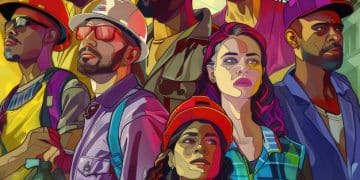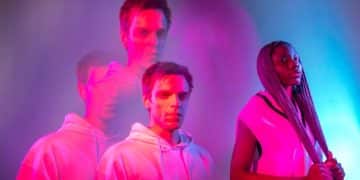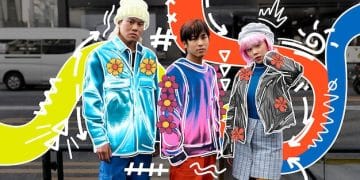Streetwear and Music: Hip-Hop’s Impact on Fashion Trends
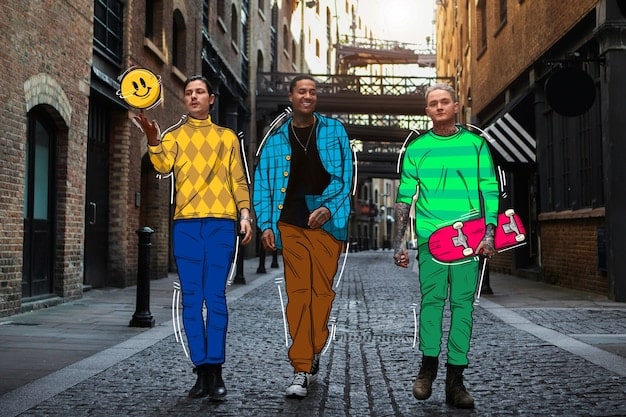
The symbiotic relationship between streetwear and music: how hip-hop influences fashion trends defines a cultural phenomenon where sonic rhythms and lyrical narratives directly sculpt the visual aesthetics of contemporary style, evolving from niche origins to global dominance.
Delving into the dynamic relationship between music and fashion reveals a compelling narrative, particularly when exploring streetwear and music: how hip-hop influences fashion trends. This iconic genre hasn’t merely provided a soundtrack; it has fundamentally shaped the visual language of an entire generation, cementing streetwear’s place in the global sartorial landscape.
The Genesis: Hip-Hop’s Blueprint for Street Style
The origins of streetwear are intertwined with the nascent stages of hip-hop culture in the Bronx, New York, during the 1970s. As DJs spun beats and MCs rhymed, a distinct visual identity began to emerge from the street, reflecting the attitudes, aspirations, and realities of its creators.
This early period was characterized by DIY aesthetics and an emphasis on comfort and practicality for dance and self-expression. Think oversized tracksuits, shell-toe Adidas, and Kangol hats – functional pieces imbued with a sense of swagger that resonated deeply with the community.
Early Adopters and Iconography
Groups like Run-DMC became early arbiters of style, their embrace of specific brands turning everyday apparel into cultural statements. Their song “My Adidas” wasn’t just a marketing jingle; it solidified the sneaker’s status as a quintessential hip-hop accessory, transforming it from athletic wear into a fashion staple.
- Run-DMC popularized Adidas tracksuits and sneakers without laces.
- Fab Five Freddy’s influence extended beyond music to art and fashion.
- Graffiti artists and breakdancers contributed to the genre’s distinct visual flair.
The spirit of innovation and defiance inherent in hip-hop found its parallel in fashion, where authenticity was paramount. Brands willing to embrace this raw energy found themselves adopted, not merely endorsed, by the burgeoning movement. This organic adoption was powerful, converting everyday consumers into brand ambassadors long before the term was coined.
The influence wasn’t just about specific items; it was about an entire ethos. It championed self-expression, individuality, and a rejection of mainstream fashion norms, setting the stage for streetwear’s future as a powerful force in global style.
From Underground to Mainstream: The 1980s and 1990s Evolution
As hip-hop gained broader recognition in the 1980s and 1990s, its fashion influence expanded exponentially. This era saw the rise of iconic labels that directly catered to the hip-hop aesthetic, moving beyond sportswear to establish distinct streetwear identities.
Luxury brands also began to appear in hip-hop lyrics and music videos, leading to a desire for aspirational high-end items. This juxtaposition of high and low fashion became a hallmark of the era, blurring traditional lines and paving the way for a more diverse sartorial landscape.
Brand Collaborations and Designer Influence
Designers like Dapper Dan from Harlem famously customized luxury goods, creating bespoke garments that blended high-fashion logos with street sensibilities. These custom pieces pre-dated official collaborations, demonstrating a demand for personalized luxury that resonated with the hip-hop elite.
- FUBU (For Us By Us) and Cross Colours emerged as leaders in urban fashion.
- Tommy Hilfiger and Nautica became unexpected favorites due to artist endorsements.
- Baggy silhouettes, oversized logos, and vibrant colors dominated the scene.
The 90s saw hip-hop artists not just wearing brands but designing their own. Rappers like Sean “P. Diddy” Combs with Sean John and Russell Simmons with Phat Farm launched successful ventures, further cementing the genre’s direct control over its aesthetic production. This shift from consumer to creator was revolutionary, providing authentic representation and economic empowerment within the culture.
This period cemented the idea that fashion was not just about clothes, but about identity, aspiration, and a powerful statement of self. The bold, unapologetic nature of hip-hop attire mirrored the genre’s lyrical confidence, creating a unified cultural expression.
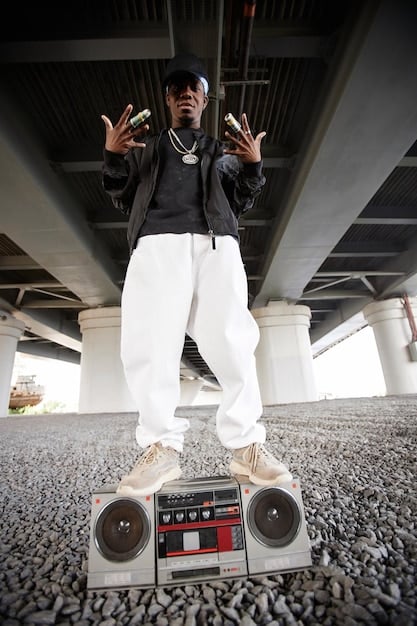
The Millennial Shift: Digitalization and Global Reach
The new millennium ushered in a period of unprecedented expansion for hip-hop and streetwear. The internet and social media platforms democratized fashion, allowing trends to disseminate globally at an accelerated pace. Artists leveraged these new tools to showcase their style directly to millions, bypassing traditional fashion gatekeepers.
This era also coincided with a growing recognition of streetwear’s commercial viability by major fashion houses. What was once considered niche urban wear began appearing on runways and in high-end boutiques, reflecting a fundamental shift in perception.
Athleisure and Luxury Fusion
Streetwear and music: how hip-hop influences fashion trends continued its evolution with the rise of athleisure, blurring the lines between gym wear, casual wear, and high fashion. Tracksuits evolved into elevated luxury sets, and sneakers became the ultimate status symbol, often commanding exorbitant resale prices.
- Kanye West’s Yeezy line propelled minimalist, utilitarian aesthetics into the mainstream.
- Tyler, The Creator’s Golf Wang brought vibrant, playful designs to the forefront.
- Drake’s OVO (October’s Very Own) blended lifestyle brand with luxury sportswear elements.
Collaborations between luxury brands like Louis Vuitton and streetwear giants like Supreme became definitive moments of this era, solidifying streetwear’s undeniable influence on mainstream fashion. These partnerships transcended mere marketing; they were cultural events, reflecting a mutual respect and a shared desire to reach new audiences.
The digital age amplified hip-hop’s ability to set trends, with artists becoming primary influencers, their style choices immediately replicated and desired by fans worldwide. This direct connection fostered a more authentic and rapid spread of fashion trends than ever before.
Sneaker Culture: The Cornerstone of Streetwear
No discussion of streetwear, particularly its connection to hip-hop, is complete without acknowledging the profound impact of sneaker culture. Sneakers are not merely footwear; they are collectible art, status symbols, and crucial components of self-expression within the streetwear lexicon.
The obsession with collecting, customizing, and reselling sneakers became a distinct subculture within streetwear, directly fueled by references in hip-hop lyrics and the visibility of artists wearing highly sought-after models. Limited editions and exclusive releases became common, creating a high-demand market.
Iconic Sneakers and Their Hip-Hop Heritage
From the early days, specific sneaker models became synonymous with hip-hop identity. The Adidas Shell Toe, for instance, gained legendary status through Run-DMC. Later, Air Jordans became the epitome of aspirational footwear, transcending basketball courts to become a global fashion phenomenon.
- Nike Air Force 1: A canvas for customization and a staple in hip-hop.
- Adidas Yeezy: Revolutionized sneaker design and scarcity marketing.
- Timberland Boots: A winter style essential, particularly in East Coast hip-hop.
The culture of “sneakerheads” emerged, driven by a passion for unique and rare footwear. This passion was often sparked directly by hip-hop artists showcasing new releases or vintage models in their videos and public appearances. The emotional connection to these shoes goes beyond functionality, reflecting personal style and a connection to a broader cultural movement.
The economic impact of sneaker culture, heavily influenced by hip-hop, is immense, with a thriving secondary market supporting an entire ecosystem of collectors, resellers, and content creators. It underscores how deeply interwoven music and fashion are within this niche.
Beyond Clothing: Jewelry, Accessories, and Hair
Hip-hop’s influence on streetwear extends far beyond just clothing and sneakers, encompassing accessories, jewelry, and even hairstyles. These elements collectively contribute to a holistic aesthetic that communicates identity, status, and affiliation within the culture.
Gold chains, initially a symbol of success and celebration, evolved into intricate, oversized pieces like “bling” that became synonymous with the genre’s audacious display of wealth and confidence. These accessories weren’t subtle; they were declarations.
From Grills to Haircuts
Grills – custom, removable dental jewelry – became a prominent accessory, adding a unique, often ostentatious, flourish to an artist’s look. They represented a continuation of hip-hop’s tradition of pushing boundaries and embracing bold, unconventional forms of self-adornment.
- Baseball caps (often worn backward or sideways) and beanies became ubiquitous.
- Bucket hats experienced resurgences thanks to artists like LL Cool J.
- Specific hairstyles, such as fades, braids, and afros, gained cultural significance.
The adoption of designer eyewear, luxury watches, and specific handbag styles by hip-hop figures further solidified their status as trendsetters. These aren’t just practical items; they are carefully chosen elements that complete a meticulously crafted image, often showcasing brand loyalty or a personal sense of luxury.
Even hair choices, from elaborate braids to sharp fades, become part of the overall fashion statement, reflecting the versatility and detail-oriented nature of hip-hop’s sartorial influence. This comprehensive approach to styling demonstrates the genre’s all-encompassing impact on visual culture.
The Future of Streetwear: Sustainability, Inclusivity, and NFTs
As streetwear continues its global ascent, its future is shaped by evolving consumer values, technological advancements, and a growing emphasis on social responsibility. The industry is responding to calls for greater sustainability, inclusivity, and innovative digital integration, driven in part by the evolving consciousness within the hip-hop community.
Younger generations are increasingly prioritizing ethical production, sustainable materials, and diverse representation in fashion. This shift is prompting brands to reconsider their supply chains, marketing strategies, and talent scouting.
Virtual Fashion and Digital Assets
The emergence of NFTs (Non-Fungible Tokens) and virtual fashion presents a new frontier for streetwear. Digital garments and accessories are gaining traction, allowing consumers to express their style in virtual worlds and blurring the lines between physical and digital ownership.
- Recycled materials and upcycling are becoming more prominent in streetwear collections.
- Brands are diversifying their ambassador rosters to reflect broader ethnic and gender representation.
- Virtual fashion shows and digital clothing experiments redefine traditional fashion consumption.
Hip-hop artists, ever at the forefront of cultural innovation, are exploring these new digital realms, collaborating on virtual apparel drops and investing in blockchain-based initiatives. This embraces a new form of scarcity and exclusivity, adapting traditional streetwear marketing for the digital age.
The conversation around mental health, body positivity, and social justice is also influencing design and marketing within streetwear, reflecting hip-hop’s historical role as a voice for marginalized communities. This ensures streetwear remains relevant and resonant by mirroring broader societal changes.
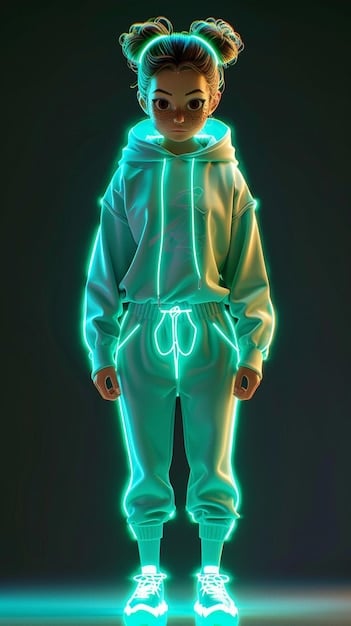
The Enduring Symbiosis
The relationship between streetwear and music: how hip-hop influences fashion trends is not a passing fad but an enduring cultural symbiosis. From its humble beginnings in the Bronx to its current global domination, hip-hop has consistently served as the primary catalyst for streetwear’s evolution.
It has provided the narrative, the aspiration, and the undeniable cool factor that transformed everyday garments into powerful statements of identity and belonging. The genre’s ability to continuously reinvent itself, embrace new sounds, and articulate current social realities ensures its ongoing relevance in shaping fashion.
A Two-Way Street of Influence
While hip-hop has undeniably driven streetwear trends, the relationship is also reciprocal. Streetwear, through its visual language, helps to define and solidify hip-hop’s image, providing a tangible representation of its ethos. The clothes become an extension of the music, a visual rhythm that accompanies the beats and rhymes.
- Artist style choices directly impact consumer purchasing patterns.
- Fashion fuels the narrative of success and aspiration within hip-hopculture.
- Streetwear provides a platform for fan identification and community building.
This dynamic interplay ensures that as hip-hop continues to evolve, so too will streetwear, adapting to new sounds, new voices, and new cultural moments. The industry continually watches the streets and the music charts for the next big trend, understanding that the powerful synergy between them is where true innovation often springs forth. The future of fashion will undoubtedly continue to bear the indelible mark of hip-hop’s creative spirit.
| Key Influence | Brief Description |
|---|---|
| 💿 Cultural Catalyst | Hip-hop’s rise birthed unique street styles in the Bronx, setting early trends. |
| 👟 Sneaker Culture | Artists popularized iconic sneakers, making them central to streetwear identity. |
| ✨ Luxury & Street Blends | Hip-hop integrated high-end brands with urban aesthetics, creating new fusion styles. |
| 🌐 Global Trendsetter | Through digital platforms, hip-hop disseminates streetwear trends worldwide instantly. |
Frequently Asked Questions
▼
The connection dates back to the 1970s in the Bronx, where hip-hop emerged. Artists and fans adopted functional, comfortable clothing that allowed for movement and self-expression, quickly creating a distinct aesthetic that evolved into modern streetwear. This organic growth forged an unbreakable bond between the two.
▼
Hip-hop heavily influenced trends like oversized apparel, tracksuits, specific sneaker models (e.g., Adidas Shell Toes, Air Jordans), “bling” jewelry, and designer brand collaborations. It also popularized specific accessory choices like Kangol hats, bucket hats, and custom eyewear, all contributing to a bold, confident look.
▼
Hip-hop artists propelled luxury brands into the mainstream by featuring them in music videos and lyrics, creating aspirational demand. This led to luxury houses seeking collaborations with streetwear labels and even appointing hip-hop figures as creative directors, bridging the gap between high fashion and street culture.
▼
Sneaker culture is paramount to hip-hop fashion, with artists transforming sneakers into highly coveted collectibles and status symbols. Limited edition releases, artist endorsements, and a thriving resale market are all direct results of hip-hop’s influence, making sneakers a central element of any streetwear outfit.
▼
In the digital age, hip-hop artists leverage social media to instantly broadcast trends globally, fostering direct engagement with fans. They are also at the forefront of virtual fashion, NFTs, and sustainable practices, ensuring streetwear remains innovative and reflective of contemporary values and technological advancements.
Conclusion
The undeniable bond between streetwear and music: how hip-hop influences fashion trends demonstrates a profound cultural exchange that continues to evolve. From the streets of the Bronx to global runways, hip-hop’s authentic voice, bold aesthetics, and relentless pursuit of innovation have consistently reshaped our understanding of style. This powerful synergy ensures that as hip-hop continues to reinvent itself, so too will the dynamic world of streetwear, forever intertwined in a rhythm of creativity and cultural impact.


